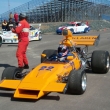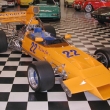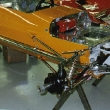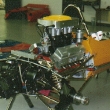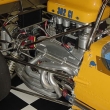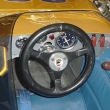1972 McLaren M22 F5000
The unknown and unloved McLaren.
British F5000 was born in 1967 from the need for a crowd drawing, financially viable, single seat formula. At the same time, The Sports Car Club of America decided they wanted to attract more attention to their single seater races, so they modified their Formula A to allow admission by cars powered by stock block 5 litre engines. Interest in both events was aroused and F5000 was born in the UK, with cars limited to a 5000 cc maximum capacity and 500 bhp.
McLaren’s first F5000 was designed by Gordon Coppuck and based on the M7A Formula 1 car. The most substantial changes Coppuck made were additions at the rear of the tub to accommodate the Chevrolet 5 litre V8 engine. The new car was named the M10A and was built by Trojan, with almost all of the seventeen cars production run aimed for America and its lucrative market. Only one M10A stayed in the UK and was raced by Peter Gethin. It was actually the prototype McLaren built chassis which Bruce McLaren himself had tested and was a high performing car, the one to beat. Gethin went on to win the Guards 5000 Championship that year. The M10A had been so successful that Trojan went on to build 21 M10Bs. The M10B was a mild improvement on its predecessor with, among other changes and weight saving initiatives, an engine that was lowered by 2 inches. The M10B continued the McLaren cars winning streak at F5000, winning the European F5000 championship, and it was a highly popular customer car.
In 1972 McLaren replaced the M10B with the stressed engine M18 but it proved to be a mistake. The M18 was difficult to set up and was unpredictable when cornering. Brian Redman ran the works M18 during its first season, but only managed two victories from the sixteen starts he made.
David Hobbs, a British driver, was recruited late in 1971 to test a modified McLaren M18. Hobbs drove the prototype M18/22 at Pukekohe for Round 1 of the Tasman Championship in January 1972. In the supposedly Formula 1 series, all but four of the starters were F5000 cars and Hobbs qualified seventh on the grid. He drove a determined race, took third on the 48th lap and this is where he finished the race, 4.1 seconds behind the winner. By this time, McLaren works were preparing the new production car, M22, for the European F5000 series. The major problem with the the whole concept of the car was that the McLaren works had lost interest in the F5000 series and instead were concentrating on the more glamorous Can-Am, Indy and Formula 1 series. Without the support and back up of the works, Trojan stopped making F5000 cars late in 1972.
Probably the only reasonable results for the M22 came in the Tasman series in 1973 where the car was run by a couple of teams, one for driver Howie Sangster. It seems a shame that such a good looking car should have had such poor results and only ever be known as the last McLaren F5000 car to take the track.
